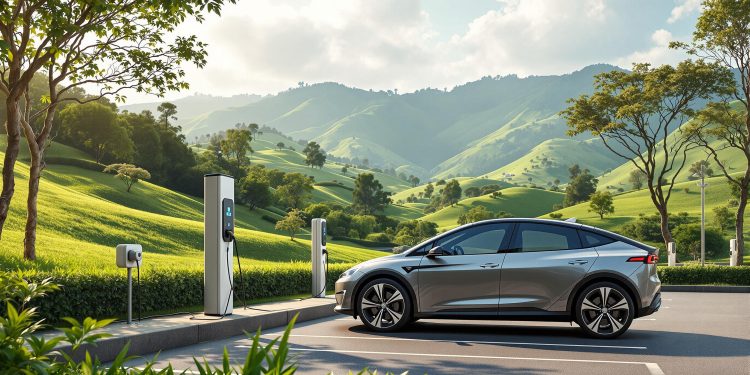Rwanda’s EV future is at risk due to limited charging infrastructure. Despite government efforts and private initiatives, the country faces critical gaps that hinder electric vehicle (EV) adoption. Here’s a quick overview of the main challenges:
- Only 5 charging stations (2024): Insufficient for growing EV numbers.
- Urban vs. rural divide: Most stations are in Kigali, leaving rural areas underserved.
- High costs: Importing equipment, grid connections, and technician training are expensive.
- Grid issues: Unreliable electricity limits charging station efficiency.
- Public awareness gaps: Misconceptions about EVs deter adoption.
Efforts like solar-powered charging, tax incentives, and public-private partnerships are underway but need scaling to meet Rwanda’s 2030 target of 20% EV adoption.
EV Charging Status in Rwanda
Charging Station Locations
Rwanda’s charging network reflects a clear divide between urban and rural areas. Kigali, the capital, hosts most of the charging facilities, including the EVPLUGIN station in Kacyiru, which serves both cars and motorcycles [5]. In contrast, rural areas have very few options, making long-distance travel a challenge.
Kabisa, the country’s largest charging network operator, has set up 23 charging points across all provinces [6]. These stations are strategically placed to ensure coverage roughly every 100 kilometers. However, gaps remain, especially along major routes. For example, the Kigali-Karongi corridor lacks sufficient fast-charging stations, leaving drivers dependent on slower AC chargers [1]. This urban focus highlights the urgent need for a more balanced rollout.
Public and Private Charging Networks
Private operators are leading the push to expand charging infrastructure, especially in underserved areas:
| Network Operator | Stations | 2024 Plans |
|---|---|---|
| Kabisa | 23 operational stations | Aiming for 38 stations [4] |
| EVPLUGIN | Flagship station in Kacyiru | Dual-use facility for cars and motorcycles [5] |
| Meshpower | Pilot projects | Solar-powered charging at corporate sites [4] |
The government is backing these efforts with tax exemptions on charging equipment [3] and special electricity rates. Commercial operators currently enjoy industrial tariffs of $0.10/kWh, which is half the standard commercial rate [5].
EV Growth vs. Charging Capacity
Rwanda’s charging infrastructure is struggling to keep pace with the country’s ambitious EV adoption goals. The current network can handle only about 50 EVs daily nationwide [4]. This is far from sufficient to meet the 2030 goal of converting 20% of vehicles to electric [3].
Charging compatibility is another roadblock. Different standards – such as GB/T, CCS, and Type2 connectors – make it difficult for EV operators to use the network seamlessly [1][4]. Vehicles imported by companies like Auto24.RW often need adapters to connect to local chargers.
Additionally, unstable power grids limit daytime charging, forcing operators to prioritize overnight sessions. These technical and logistical challenges must be addressed quickly to meet Rwanda’s 2030 targets for EV adoption.
Electric Vehicle Charging Infrastructure in Rwanda
Main Charging Infrastructure Problems
Rwanda’s charging network expansion faces three major obstacles beyond just technical compatibility challenges:
Setup and Running Costs
Even with government incentives, operators encounter high initial expenses. These include costs for importing equipment, acquiring land, and connecting to the grid [8].
Ongoing costs are another hurdle. Certifying an EV technician costs €5,000, and spare parts take 6-8 weeks to arrive from China [10][6]. For instance, Kabisa’s EV garage in Kigali incurs labor costs that are 35% higher than those of traditional workshops [6].
| Cost Component | Impact on Operations |
|---|---|
| Equipment Import | High upfront investment despite duty waivers [8] |
| Technical Training | €5,000 per technician certification [6] |
| Spare Parts | Long delivery times (6-8 weeks) [10] |
| Labor Costs | 35% higher than ICE vehicle maintenance [6] |
Power Supply Issues
Grid reliability is a major concern. Urban areas experience voltage fluctuations that damage DC chargers, while rural regions often lack consistent electricity [3][9].
The Western Province illustrates the scale of the problem, with only one charging station per 250km² [9]. Additionally, there are no mandatory timelines for grid upgrades near planned stations, causing deployment delays of 6-9 months [2].
Public Knowledge Gaps
Misunderstandings about EV charging remain a barrier to adoption. A survey found that 62% of drivers mistakenly believe EVs need over 8 hours to charge, even though DC fast chargers only take 30-45 minutes [3]. Among commercial transporters, awareness is even lower – just 22% are aware of battery swapping stations, compared to 68% of private vehicle owners [4].
Rural communities face even more challenges. In Nyamagabe District, farmers travel an average of 70 kilometers to reach agricultural EV charging points, despite the national goal of ensuring access within 50 kilometers [2]. Rural women entrepreneurs are particularly affected, with 89% unsure about the feasibility of solar charging [9].
Efforts like Kabisa’s test drive programs at partner gas stations have attempted to address these gaps, but misconceptions still persist. This lack of awareness directly threatens Rwanda’s 2030 EV adoption targets, highlighting the need for stronger educational campaigns [8].
sbb-itb-7bc66b5
Ways to Fix Charging Network Gaps
Solar Charging Options
Solar-powered charging stations offer a cost-effective way to address power reliability issues. For example, Meshpower’s pilot program with Kabisa has shown that installation costs for solar stations range between $15,000 and $50,000, which is far less than the $100,000+ typically required for high-power grid stations [4][5].
These solar stations also bring down energy costs to just $0.03-$0.05 per kWh, while significantly reducing reliance on the grid [5]. EVPLUGIN’s hybrid systems, which integrate renewable energy components, ensure a steady power supply even when the grid is unstable [5]. This approach directly tackles the challenges of grid instability and high initial setup costs.
| Charging Solution | Installation Cost | Operating Cost (per kWh) | Grid Dependency |
|---|---|---|---|
| Solar Station | $15k-$50k | $0.03-$0.05 | Minimal |
| Grid Station | $100k+ | $0.10 | High |
| Hybrid System | $75k-$90k | $0.06-$0.08 | Moderate |
Government-Business Cooperation
Partnerships between governments and businesses have proven to be effective. Kabisa, through its SP collaboration, has successfully installed 15 new charging stations [7]. Similarly, IZI Electric and Basigo have expanded their networks with support from the Rwanda Green Fund [4]. Organizations like JICA and KOICA also play a key role by offering technical assistance for planning station locations, which helps operators save time and resources [4].
These cooperative efforts have enabled Kabisa to move forward with its plan to establish a charging station every 100 kilometers along Rwanda’s main highways [7]. This aligns with the Ministry’s projection of 226 potential sites for charging infrastructure [2].
Public Information Programs
To address misconceptions and knowledge gaps, AutoMag.RW has introduced home charging guides and conducted range tests for popular EV models in Rwanda [context]. These efforts aim to educate the public about charging times and ease concerns.
Kabisa’s awareness campaigns are also making an impact. Their charging guide website has seen traffic increase by 300% year-over-year [7]. Additionally, the Rwanda Energy Group now provides grid capacity maps, which help drivers locate the best charging zones [4].
"By integrating charging stations into familiar locations, we’re making EVs more approachable", says a Kabisa representative [6].
Policy Changes Needed
While technical solutions like solar charging hold potential, policy reforms are key to making large-scale implementation a reality.
Speeding Up Station Approvals
Rwanda’s current process for approving charging stations involves multiple agencies and can take up to 90 days [3]. This slows down the rollout of essential infrastructure. A more efficient approach would be adopting a digital "single-window" system, like Kenya’s model, which cut approval times to just 21 days [5][4]. Streamlining this process through the Rwanda Development Board could significantly reduce delays.
Financial Support for Operators
To address the gap in charging capacity, the government has already introduced VAT exemptions on imported charging equipment and capped electricity tariffs at $0.10/kWh for stations [5][11]. However, these measures alone won’t be enough to meet infrastructure goals. Drawing inspiration from successful regional initiatives, Rwanda could consider introducing the following:
| Support Mechanism | Details |
|---|---|
| Installation Grants | $3k/charger (2025) |
| Tax Holidays | 5-year exemption (2025-2030) |
| Smart Meter Subsidies | 50% cost coverage (2025-2026) |
Such incentives would make operating charging stations more feasible and help Rwanda achieve its target of converting 20% of vehicles to electric by 2030 [1].
Upgrading the Power Grid
The current power grid is another hurdle, with only 52% of connections capable of supporting high-power chargers above 50kW [4]. The Kigali-Northern Corridor highway is a priority area for upgrades, especially for substation reinforcements needed to support fast-charging stations [1]. These improvements would complement ongoing solar charging projects by ensuring a dependable power supply.
Programs like those funded by KOICA, which focus on grid resilience, provide a solid framework for modernizing infrastructure. These upgrades would directly benefit the 226 charging sites identified by the Ministry, making the grid capable of supporting future demand.
Rwanda’s EV Charging Challenges and Opportunities
Rwanda’s electric vehicle (EV) charging infrastructure faces real challenges, from the lack of charging stations in key areas to limitations in the power grid. These gaps force drivers to depend on slower chargers, underscoring the need for a more extensive and efficient network.
Solar-powered stations, like Meshpower’s pilot project, offer a practical alternative to grid-reliant systems, especially in areas with inconsistent electricity supply. Expanding this type of infrastructure will require long-term investment, but partnerships between public and private entities are already proving effective in speeding up network development.
Technical advancements are also paving the way for improvements. Solar-powered charging solutions, in particular, can help reduce the anxiety drivers feel about running out of power during inter-city trips. These innovations are crucial for building a reliable and accessible charging network.
Platforms like AutoMag.RW play a key role by providing drivers with essential details about charging stations. From station locations and EV compatibility to practical insights from early adopters, these resources help users navigate Rwanda’s evolving EV landscape.
To meet its 2030 goals of 20% EV adoption and a 38% reduction in emissions, Rwanda must focus on three priorities: policy support for charging operators, upgrading the power grid, and running public education campaigns. These combined efforts will help the country move closer to its ambitious targets [1].
Related Blog Posts
- Rwanda EV Import Duty Exemptions Explained
- How Rwanda’s Hills Affect EV Range
- EVs vs. ICE Cars: Performance on Rwanda’s Roads
- Popular Hybrid and Electric Cars in Rwanda





